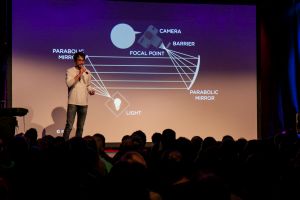Entertaining science slam with guarantee for laughs? Visually stunning explanation video on the internet? Or rather a classical PowerPoint presentation? There are various ways of scientists presenting their work to the public. But which types of presentations are suited for which purpose and what makes the presentation successful? Karlsruhe Institute of Technology (KIT) and the National Institute for Science Communication (NaWik) wish to answer these questions by their research project “Science in Presentations”. Project duration will be three years.
Scientists have always given oral presentations for a non-expert audience. Classical presentation has long been complemented by the use of various visualization methods. Apart from real objects, pictures, graphics, videos, and animations illustrate the content and provide insight into research. But which types of presentations are preferred by scientists, if they are to appear in the public? And what is the difference between a PowerPoint-based presentation for the Open Day, science slams, or online presentations on the internet?
These and other aspects are studied under the project “Science in Presentations” by the Science Communication Group of the Institute for German Studies of Karlsruhe Institute of Technology (KIT). The project is scheduled for three years, KIT’s project partner is the National Institute for Science Communication (NaWik) that offers communication seminars for scientists. The research project is funded by the Klaus Tschira Foundation.
Project Head Dr. Phlipp Niemann, KIT, considers cooperation with the experts of NaWik a strength of the project. “In this way, it is ensured that our research focuses on those types of presentations that really play an important role in practice.”
Apart from the development of a typology of presentation forms, the audience – the users of such presentations – are in the focus of the project. What do they expect? How do they deal with the presentations and where do communication problems arise? These aspects will be studied empirically using innovative scientific methods, from surveys to the recording of eye movements (eye tracking).
In addition, the researchers will study various elements of presentations and their positive or negative effects on understandability. For this purpose, experts of NaWik will set up different presentations, for instance, presentations with a higher or lower share of images or explaining graphics, and compare them. “From these comparisons, we will be able to derive recommendations for successful presentations, which will also be incorporated in the NaWik teaching program,” NaWik Director Beatrice Lugger explains. Based on empirical research, guidelines for drafting selected presentations are planned to be set up in a second project phase.
More information on the project can be found at:
www.science-in-presentations.de (in German only)
The Science Communication Group of the Institute for German Studies of Karlsruhe Institute of Technology (KIT) has been studying and teaching communicative products, processes, and interactions between science and the public since 2013. The Group is responsible for the bachelor’s program Wissenschaft-Medien-Kommunikation (Science-Media-Communication) and the consecutive master’s program. The chairs held by Professor Dr. Annette Leßmöllmann and Professor Dr. Carsten Könneker pursue a clearly interdisciplinary approach to research, which combines media and communication sciences with linguistics and psychology as well as literature and film sciences.
The National Institute for Science Communication, a non-profit limited-liability company, was established by the Klaus Tschira Foundation and KIT in 2012. Cooperation partner is the publishing company Spektrum der Wissenschaft. The Institute conveys to researchers and students the fundamentals of understandable and good science communication with non-specialists. Currently, NaWik offers nine seminar types based on a standardized didactic concept, from writing and presentation seminars to science slam seminars. Open seminars are organized in Karlsruhe. In-house seminars can be booked all over Germany.
Being “The University in the Helmholtz Association”, KIT creates and imparts knowledge for the society and the environment. It is the objective to make significant contributions to the global challenges in the fields of energy, mobility, and information. For this, about 10,000 employees cooperate in a broad range of disciplines in natural sciences, engineering sciences, economics, and the humanities and social sciences. KIT prepares its 22,800 students for responsible tasks in society, industry, and science by offering research-based study programs. Innovation efforts at KIT build a bridge between important scientific findings and their application for the benefit of society, economic prosperity, and the preservation of our natural basis of life. KIT is one of the German universities of excellence.

